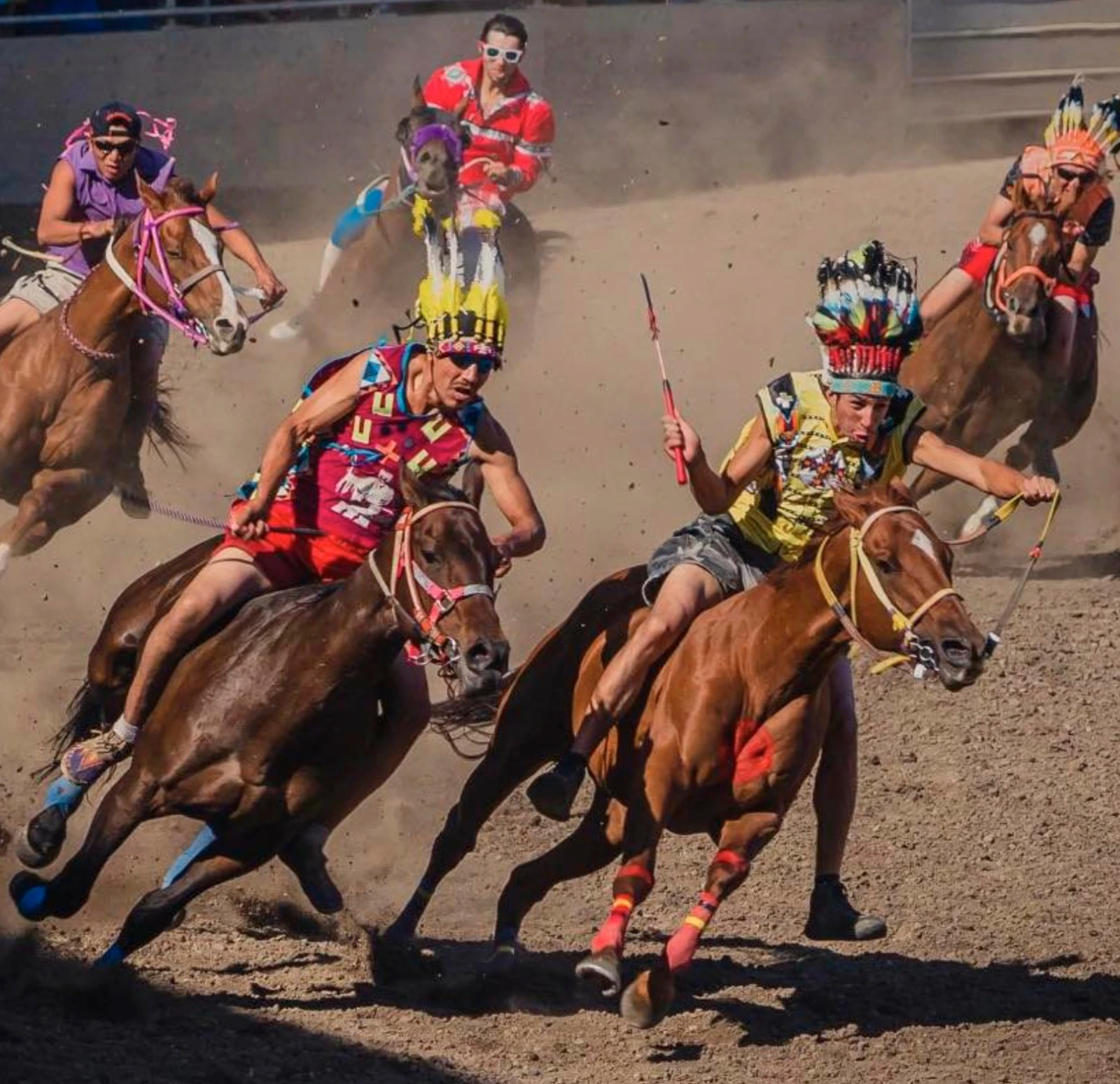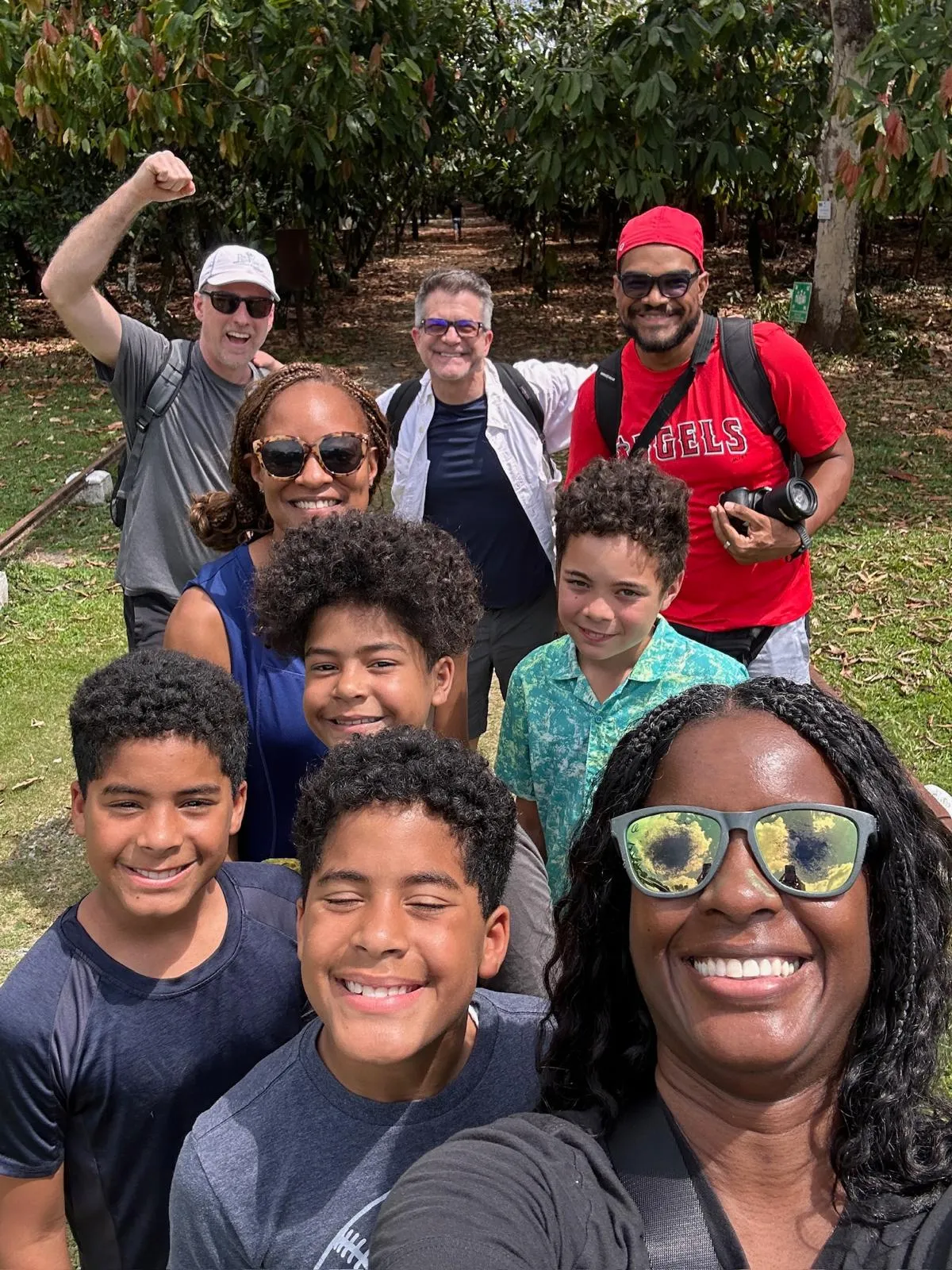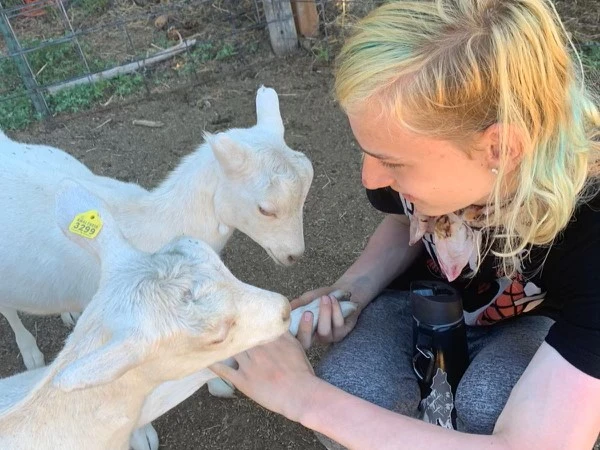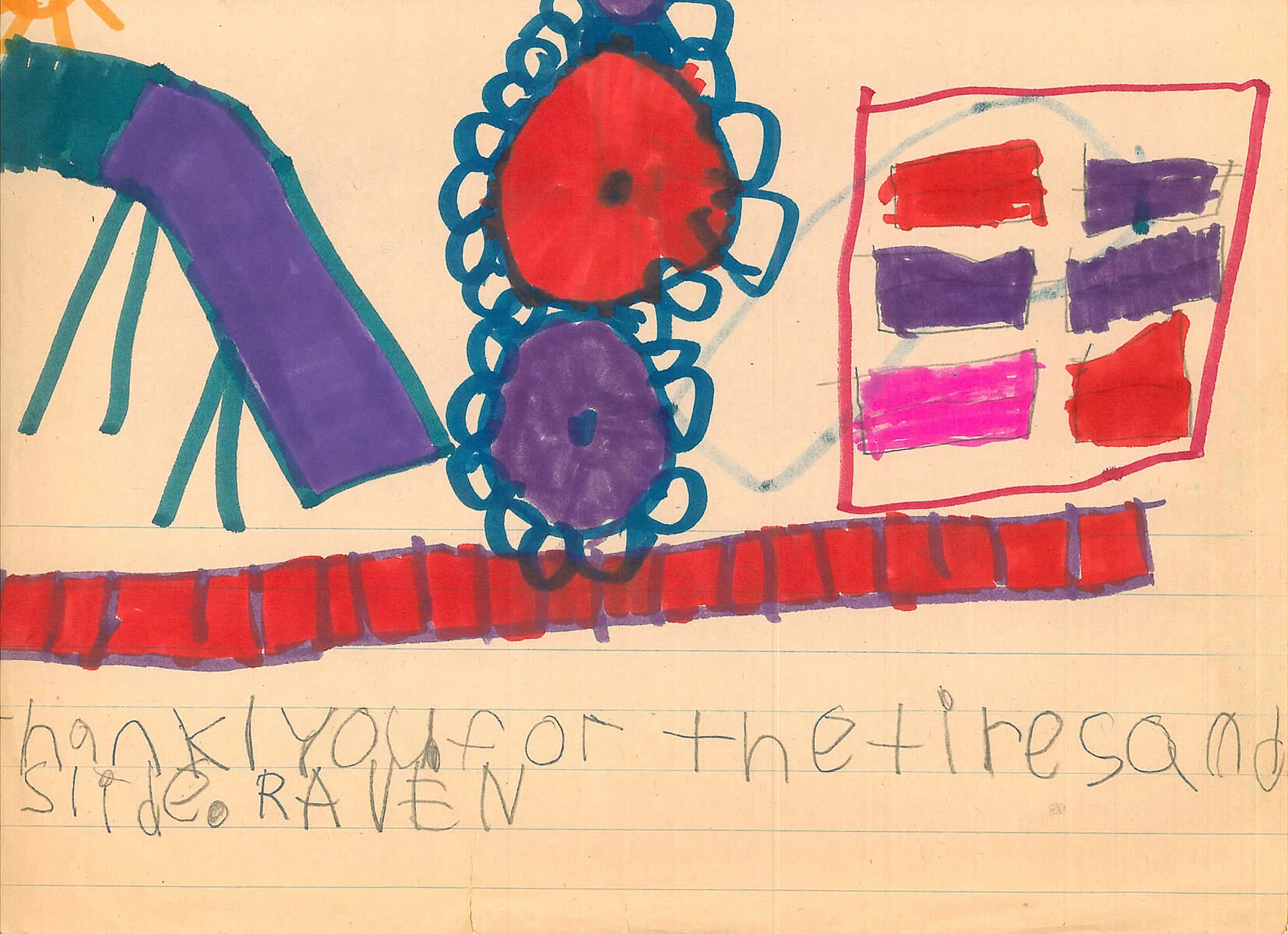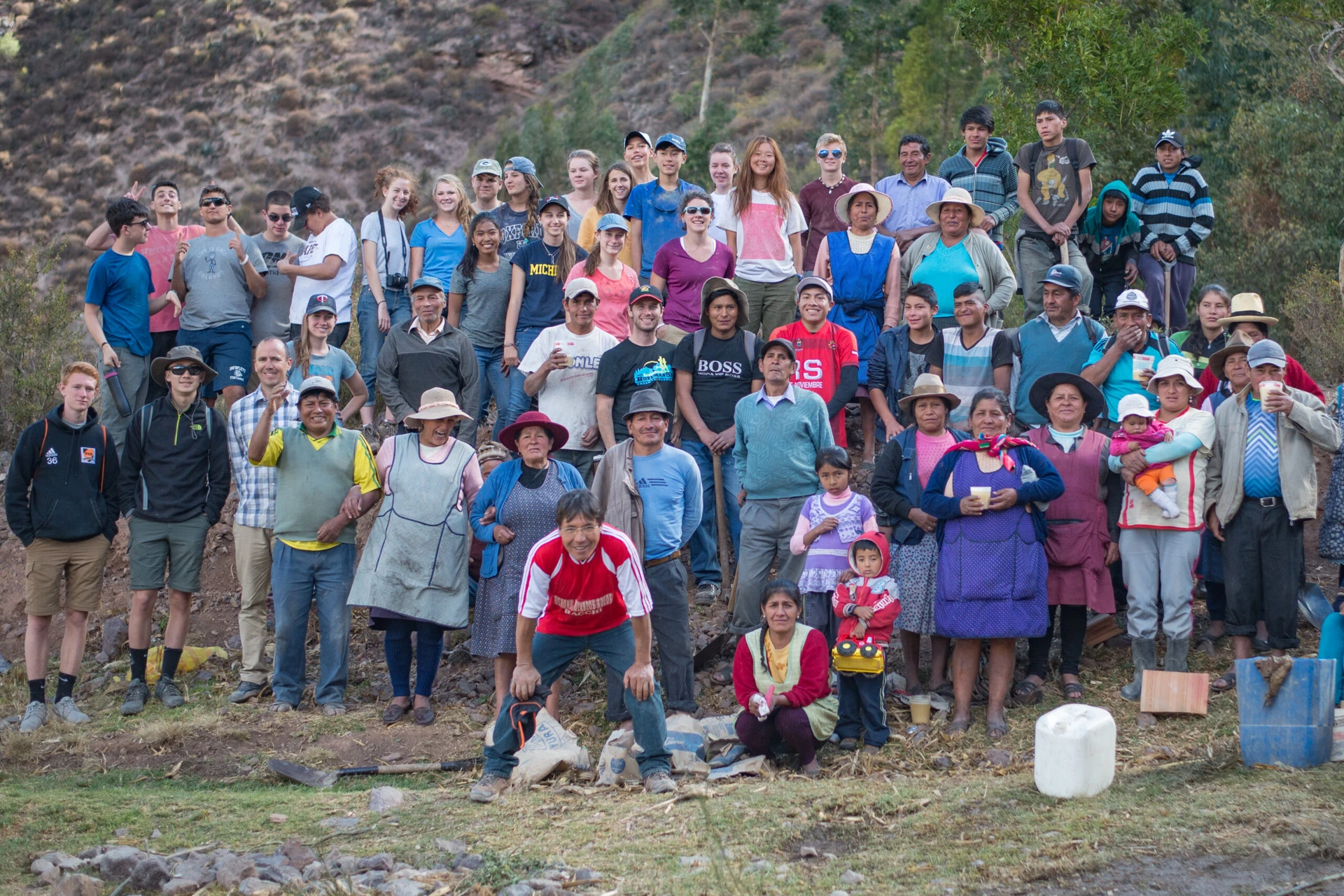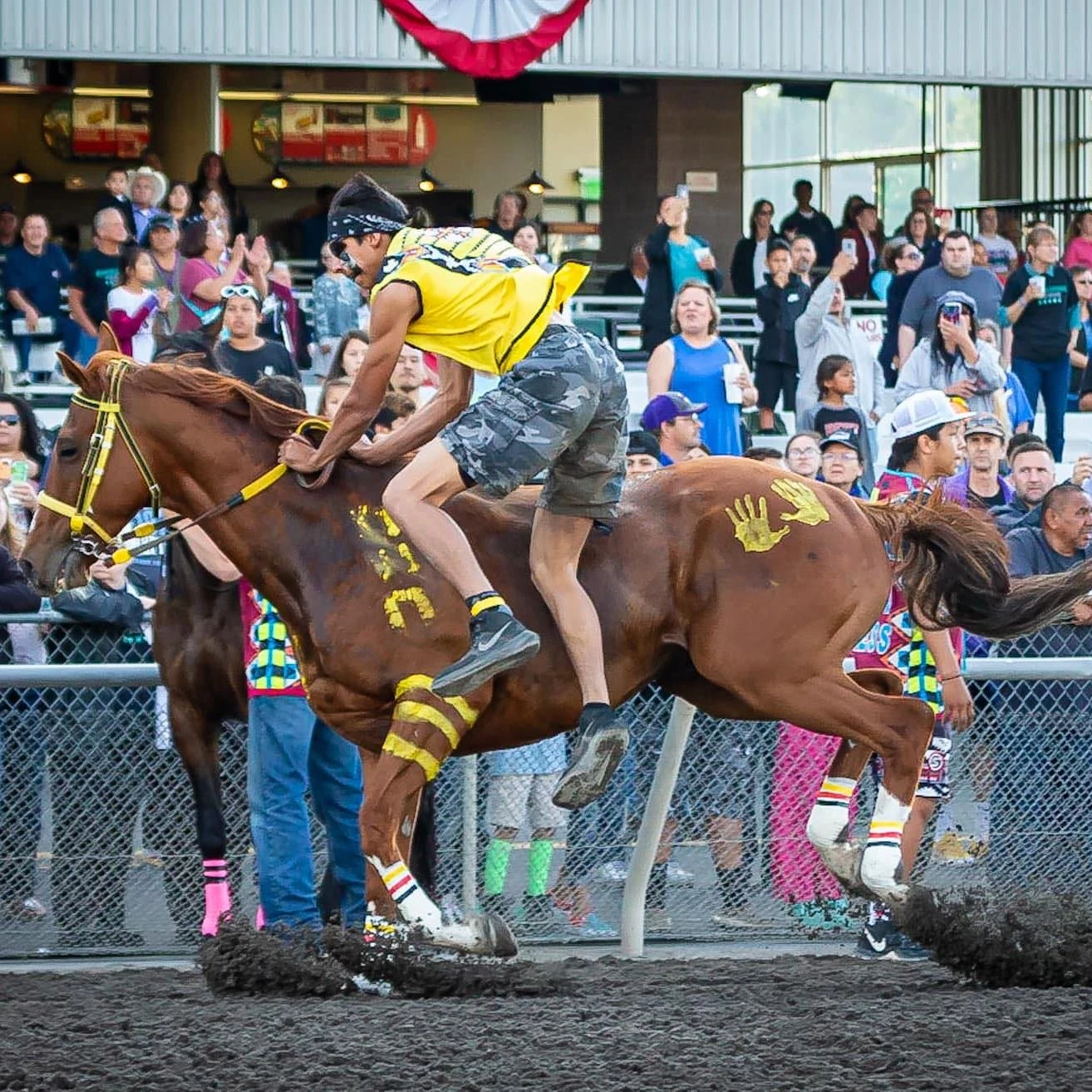
Emerald Downs, Auburn, WA
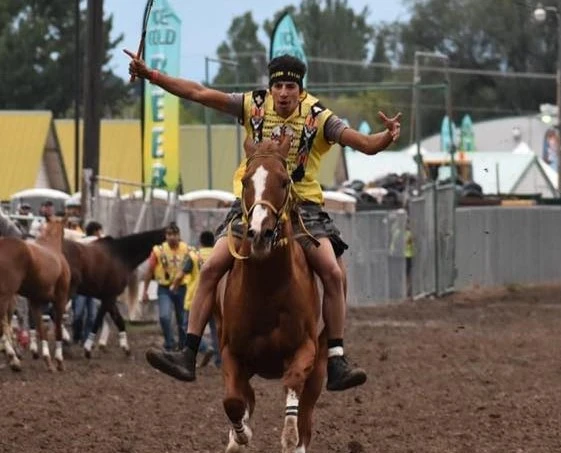
In the world of Indian Relay horseracing, Blackfeet tribal member Chazz Racine is something of a legend. He’s ridden bareback since he was only five years old and today has numerous competitive wins under his belt, including the renowned Gold Cup Indian Relay Championship at Emerald Downs.
Indian Relay races date back a hundred years. Riders go full speed and bareback around a half-mile track and leap from one horse to the next, and next, and next—three horses. Jumping off a Thoroughbred/Quarter horse (or any horse, for that matter) while it’s still in motion can be dangerous and requires athletic prowess, lots of practice, and a connection to the animals. Chazz is the rider and each relay team also includes a holder, who holds the upcoming horse, and a mugger, who catches the incoming horse.
This past summer, VISIONS participants had the thrill of watching Chazz crush the competition and take first prize during the annual Blackfeet Indian Day celebrations, chalking up yet another of his many wins.
Watch Chazz win the Calgary Stampede
Lucky for us, Chazz is also a special part of our Montana Blackfeet summer program! When he’s not busy with the races and his other responsibilities, Chazz meets up with VISIONS participants to work on repairing and installing fencing, a hallmark type of project in the West. His mother, Joan Cobell, also works with the program as our dinner cook.
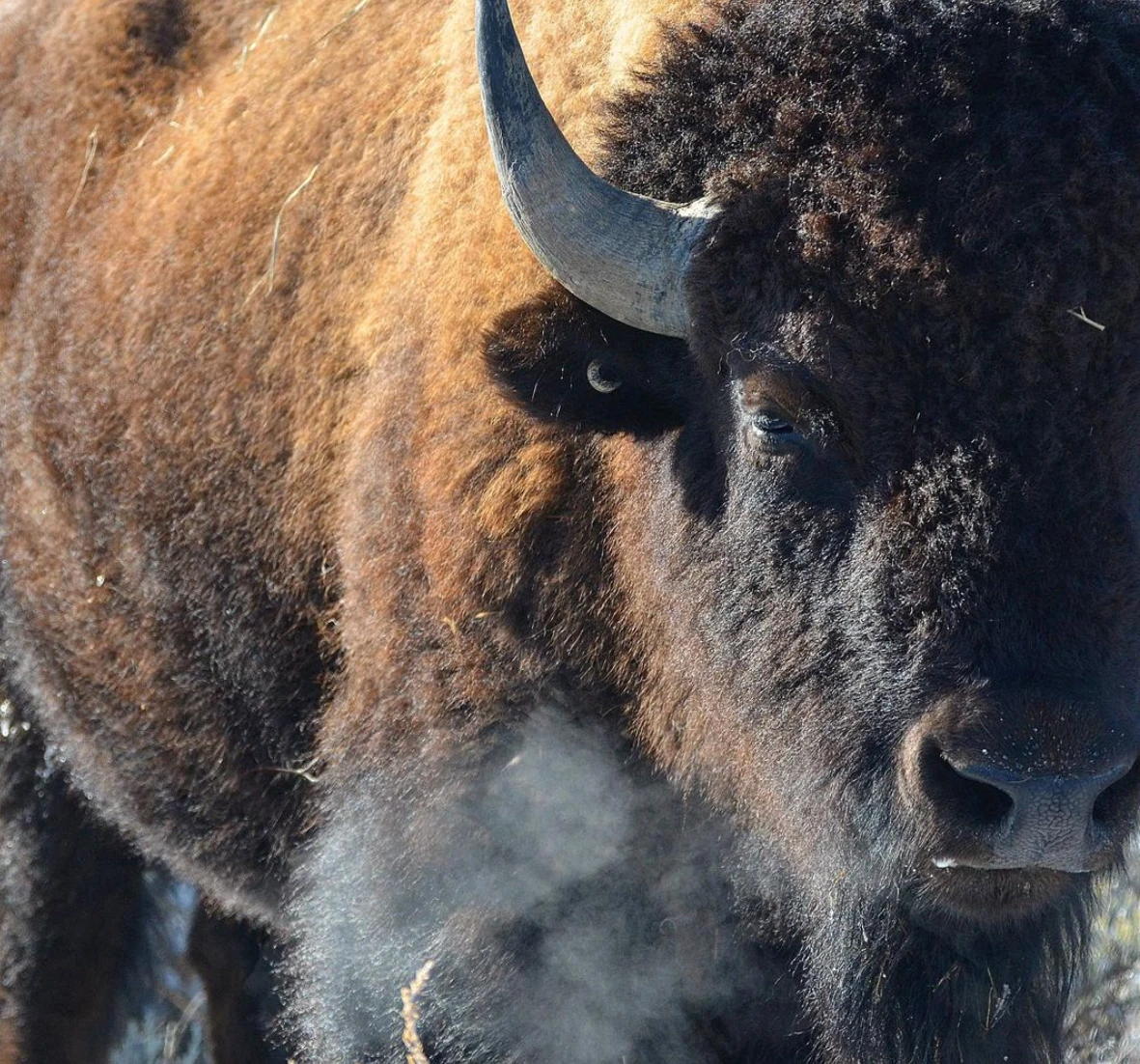
Chazz works with the Iinnii Initiative (aka “Buffalo Program”). Launched in 2009 by leaders from the four tribes that make up the Blackfoot Confederacy—the Blackfeet, Kainai, Piikani and Siksika nations—the program is a partnership with the Wildlife Conservation Society and works towards the goal of conserving traditional lands, protecting Blackfeet culture and expanding the grazing lands for the buffalo to call home. (At the time of the interview, Chazz was in Oklahoma for the Intertribal Buffalo Council 30th Anniversary.)
Buffalo were driven nearly to extinction by settlers in the 1880s, and the Iinnii Initiative hopes to build back their numbers on the reservation. This won’t just benefit the buffalo and the Blackfeet people, but also the fragile prairie ecosystem where the buffalo play a crucial role with regenerative agriculture.
Chazz’s father, Ervin Carlson, is a key leader in the initiative, serving as president of the InterTribal Buffalo Council and overall manager of the Blackfeet Nation’s buffalo herds. “These animals are culturally and spiritually connected to our people and I believe their homecoming will begin a healing of historical trauma to the Blackfeet people,” Carlson told the Oakland Zoo, a program partner. Ultimately, the Iinnii Initiative hopes to build the herd to several thousand on the Blackfeet tribal lands (bordering the Glacier and Waterton Lakes National Parks), which will most certainly mean even more pasture fencing projects that VISIONS participants can do with Chazz.
In addition to expanding the herd size and grazing lands, one of the important undertakings of the Iinnii Initiative is to provide buffalo meat to tribal members and sell the meat in local markets and beyond. VISIONS participants are among the consumers of this delicious and organic protein source, thereby playing a role in the full circle needed to further develop sustainable food sourcing on reservation lands.
Below, check out an interview between Chazz and our Director of Outreach, Amanda Pincock. Some of the interview has been edited for length and clarity.
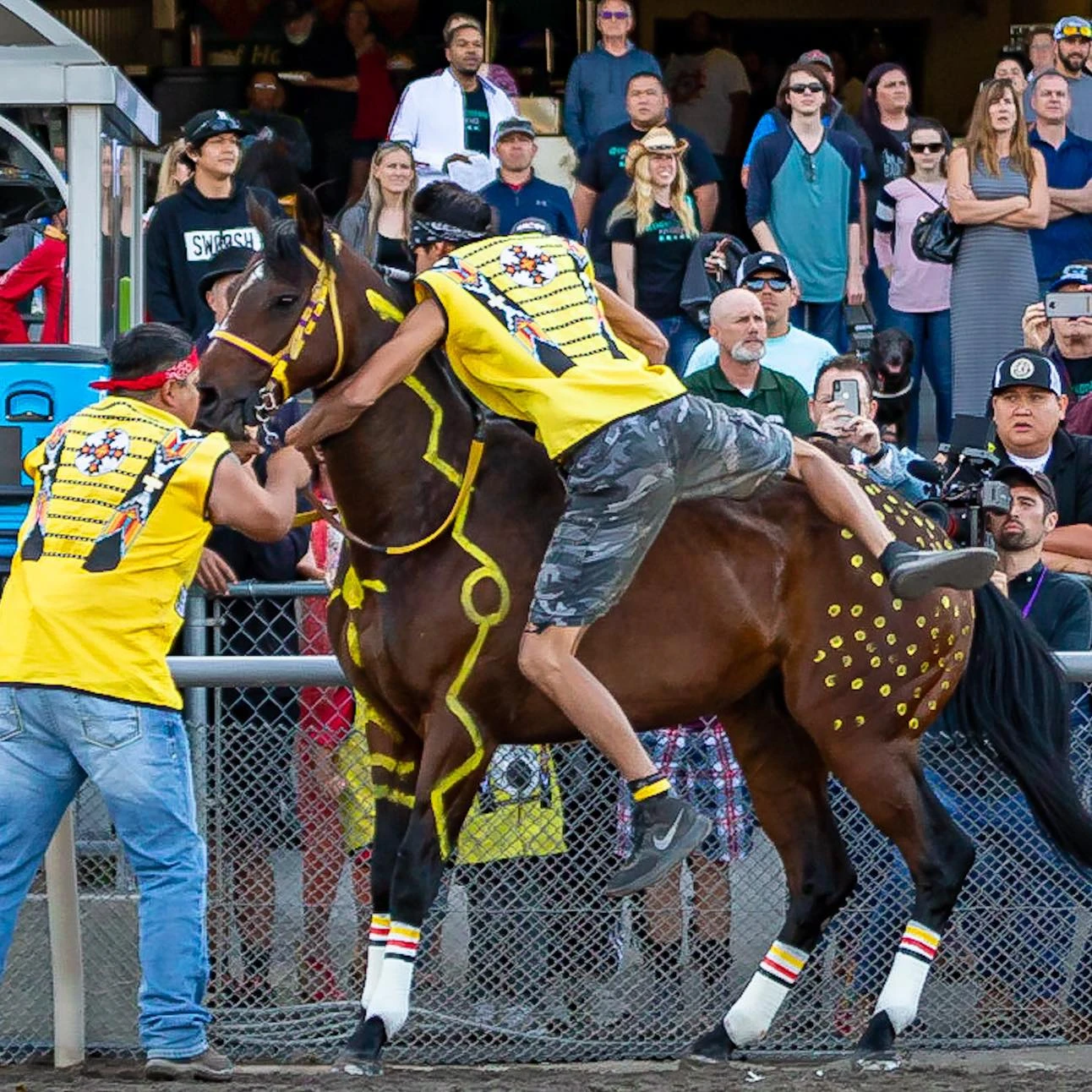
Can you tell us a bit about your family and your personal life?
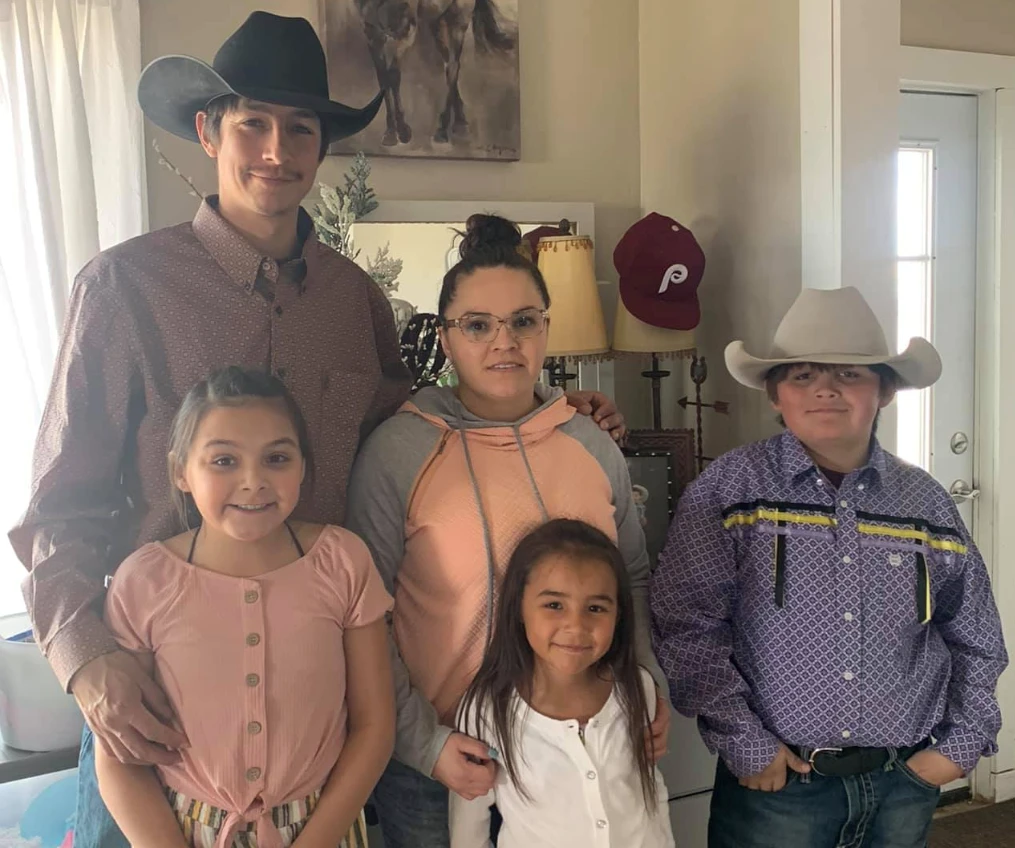
I’m Chazz Racine from the Blackfeet Nation. My Indian name is Tall Eagle, “Pitaspita” in Blackfeet. I’ve lived there my entire life, my family has lived there their entire lives. My grandparents raised me. They were both ranchers, we grew up raising cattle, we rodeoed our whole lives, raced, did Indian Relays. Now we’re really into relay. We have two teams—my nephew has one and I have one. He’s like a prodigy of mine—he grew up watching me—and he’s now a really good rider. A champion, too.
I’m married and I’ve been with my wife for 13 years. Her name is Jace. We have three babies—my boy, my firstborn, he’s 13. My middle child just turned 11, and my baby, she’s 8. They compete in rodeo and mini-relays, pony relays. They’re really competitive and they support me in everything I do. My son is really into it.He and my daughters really enjoy being around the horses. My wife is almost done with teacher training, and she’s gonna be a teacher here in the next year.
My wife and I speak some Blackfeet, we’re not fluent. My friend Shane, Little Bear, he’s a fluent speaker and he’s also into ceremonial life. We go to a lot of ceremonies over there in Canada.
How about Indian Relay? How & when did you become involved?
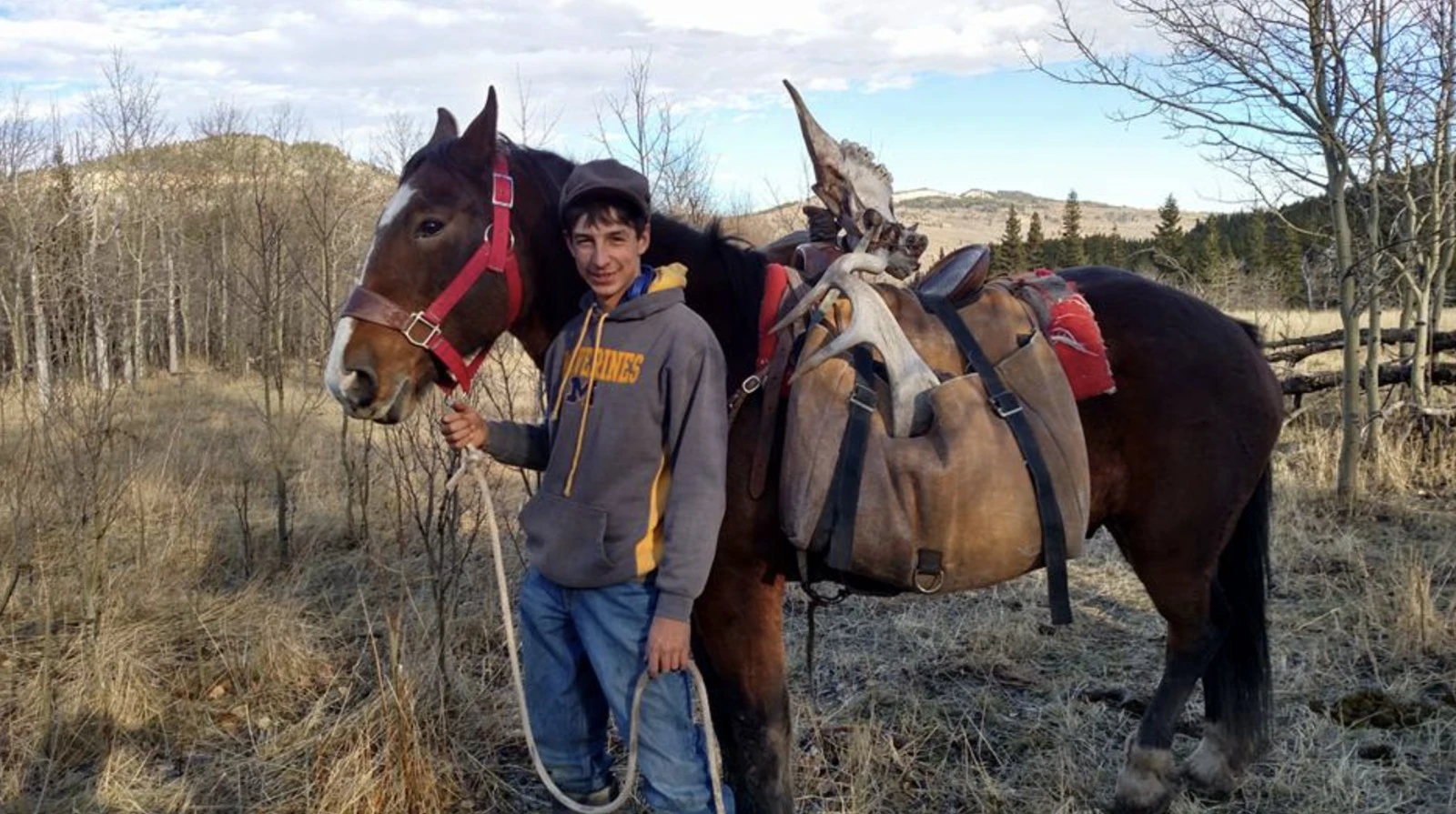
[I’ve] been involved since I was a little tiny kid. My dad Ervin Carlson did it with his family. They did a lot of regular horse racing; they had relay but the form it’s in now didn’t start til 1980. He and my uncle had their own team together. They raced for three to four years in a small circuit all over Montana at different state fairs back in the 80s when it really started. I was born in 1988 and so I was already into it.
From the time I can remember, since I was four or five years old, I was helping with chores. When I was about five, I started riding bareback. My first relay race I was 11 years old. My first real race was when I was 12 and I got to race against the men. After that I just kept progressing. As I got older my dad would buy better thoroughbred horses, and then we got faster, our horses got better. Throughout the early 2000s we just relayed, we started to get bigger.
I rode for an uncle of mine. We didn’t have a team. When I was 17, I won the Eastern Idaho State Fair. From there we went on into Canada and started racing, in part of our Confederacy. 2015 was the first year they had Indian Relay at Emerald Downs. It was Horse Nation (now Gold Cup).
I was the very first one to race relay on that track before it was Gold Cup. They did a demo and we had to race the jockeys. They had their little jockey saddles and we were bareback. I still wanna get that film, that was years ago. In 2016 was the first Gold Cup and we won that, too. All the way up to 2020, we’ve been in all the Gold Cup Championships. Actually a pretty big accomplishment just to be in that race. We went to Calgary Stampede, Pendleton Round Up… I rode saddle bronc for quite a few years. In 2013 I had a really bad neck injury so I had to take time off. I came back in 2015 and won the Emerald Downs. We have a lot of people that support us, we have decent sponsors.
What does Indian Relay mean to you?
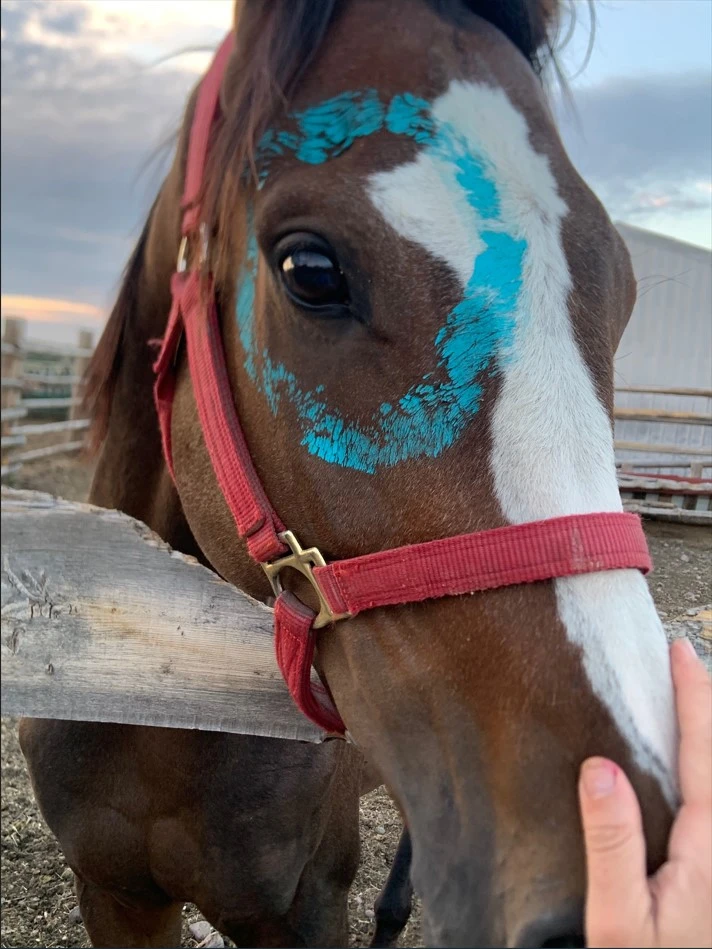
I love it. I train my own horses. My family is really involved, too. My uncle and his boys run their string of horses. Plains people are the ones really into relay, and now coastal regions and Flatheads, and up into Canada. A lot of tribes do it now. Shoshone-Bannock did it for a long time. I think Blackfeet and Shoshone have done it the longest. Blackfeet and Shoshone have always been horse people. They’ve been doing it a lot longer than all the other tribes.
It means a lot. It’s a lot of hard work, dedication, you gotta be very humble, committed and dedicated. Those are the main things I get out of it. It keeps me healthy because I have to work hard at it. I’m just as healthy as the horses because I have to work as hard as them.
My horses are good medicine is what we say. They’re really grounding. If you’re kind to them and take care of them, they’ll take care of you. They help you. If you’re having a problem and you go ride a horse, you just feel better. The native people have a connection with them. Especially when you’re working with relay, you work so closely with them every day. It means a lot to me. I try to better myself at it every time I do it, with my horse, with my team.
My team is everything—my holders, my catchers, they’re a big backbone in that team. It’s not just me. My horse has to trust my team, too. It’s a pretty big deal.
When I get up in the morning, I pray for my horses. I smudge for my horses, I smudge for who needs prayers. That’s what keeps me close to my culture, is racing. When I step onto that track it’s a serious matter. Anything can happen. I can get hurt, my horse can get hurt. Before you get on the track you’re praying to protect your horse, yourself, everybody. That’s what mak
We start in springtime. We ride our horses, get our horses legged up, ride them slow to get them muscled up so we can start galloping them. Once we leg them up we start bringing them into the track, start giving them little exercises and pushing them further. We like to get 90 to 100 days of legging them up before we get into racing.
We get up early and feed them, water them. We keep them in box stalls with clean bedding, water and hay every day. So it’s morning, afternoon, evening, every day. They get a walk in the morning, and then evening is when they get their exercise, cause we’re off work. We practice with the team, the holder, the catcher [aka mugger], me. Sometimes we bring them to Browning to practice at the race track. Racing is June to September, sometimes late May and early October. In all, it’s about four to five months of racing.
Didn’t you do some modeling for Carhartt?
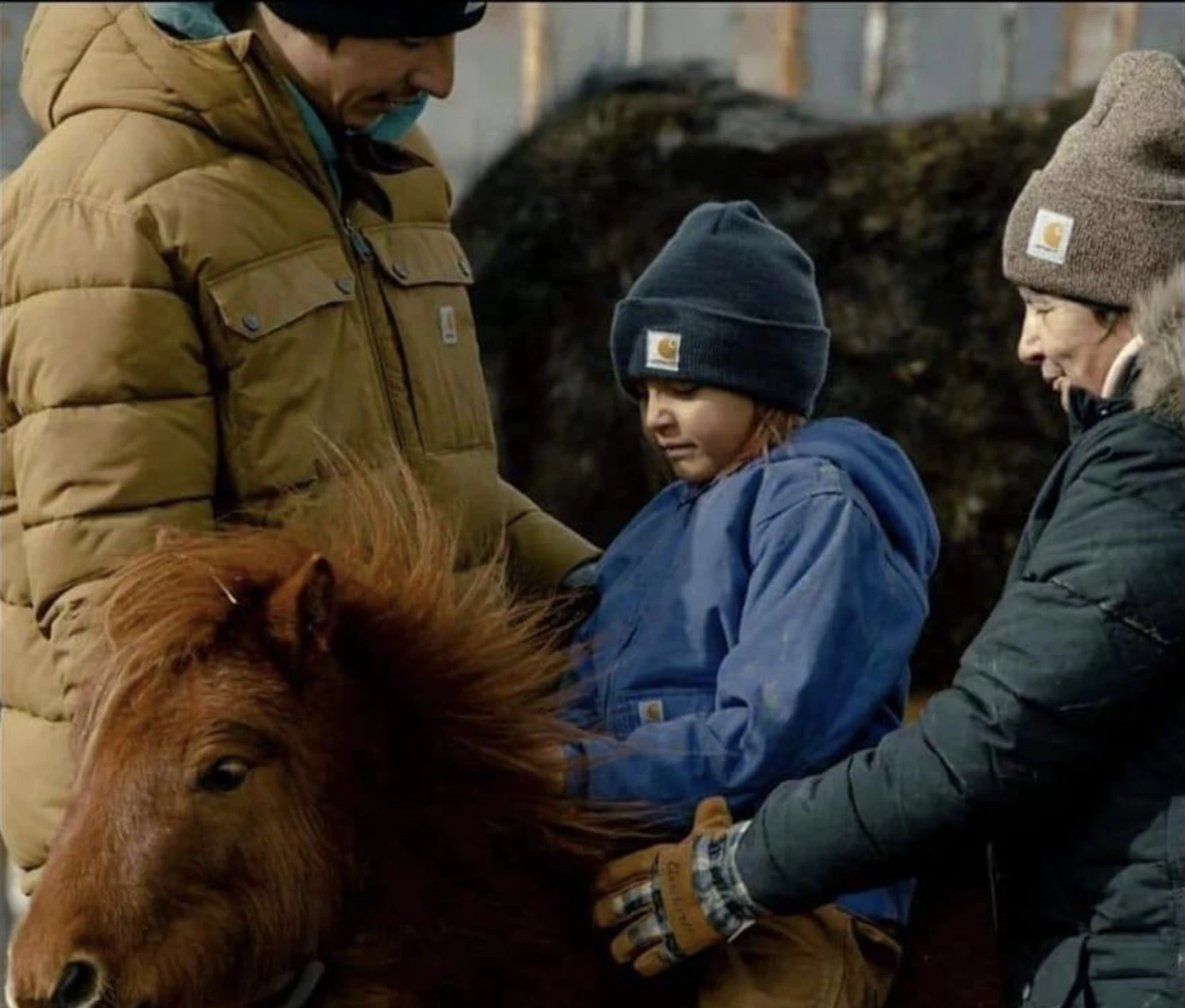
A [photographer] contacted me who was [trying to shoot] for Carhartt. He knew me through relay, and knew that I worked for the Buffalo [Program] and that I had my own ranch. He said he’d come take pictures of our place. He got the gig and now my picture is everywhere in stores where it’s sold. I got paid for it, and Carhartt wants to sponsor my relay team. It would be really smart of them if they did, we travel all over. Me being a Native, that’s the first time they used a Native person. It was fun working with that team of people, and my whole family was in it, too. Wife, kids, uncle and his family, my dad—we all got to be part of it.
What else do you do for fun?
I’ll go camping in the mountains and hunt. And relay. And being with my family, playing with my kids. My kids dance, my daughters do. I used to dance when I was a little kid, but then I started racing. It’s part of our culture so I did it when I was real young. Most Indian kids do dance, if they can. Some don’t have the opportunity. Maybe their parents didn’t do it so they don’t pass it down, maybe they don’t have the resources to get the outfits. Not everyone is as fortunate to have been brought up in a family that’s had that for generations. My uncles and brothers had danced, so I was fortunate to have been raised with that opportunity.
How did you become involved with VISIONS?
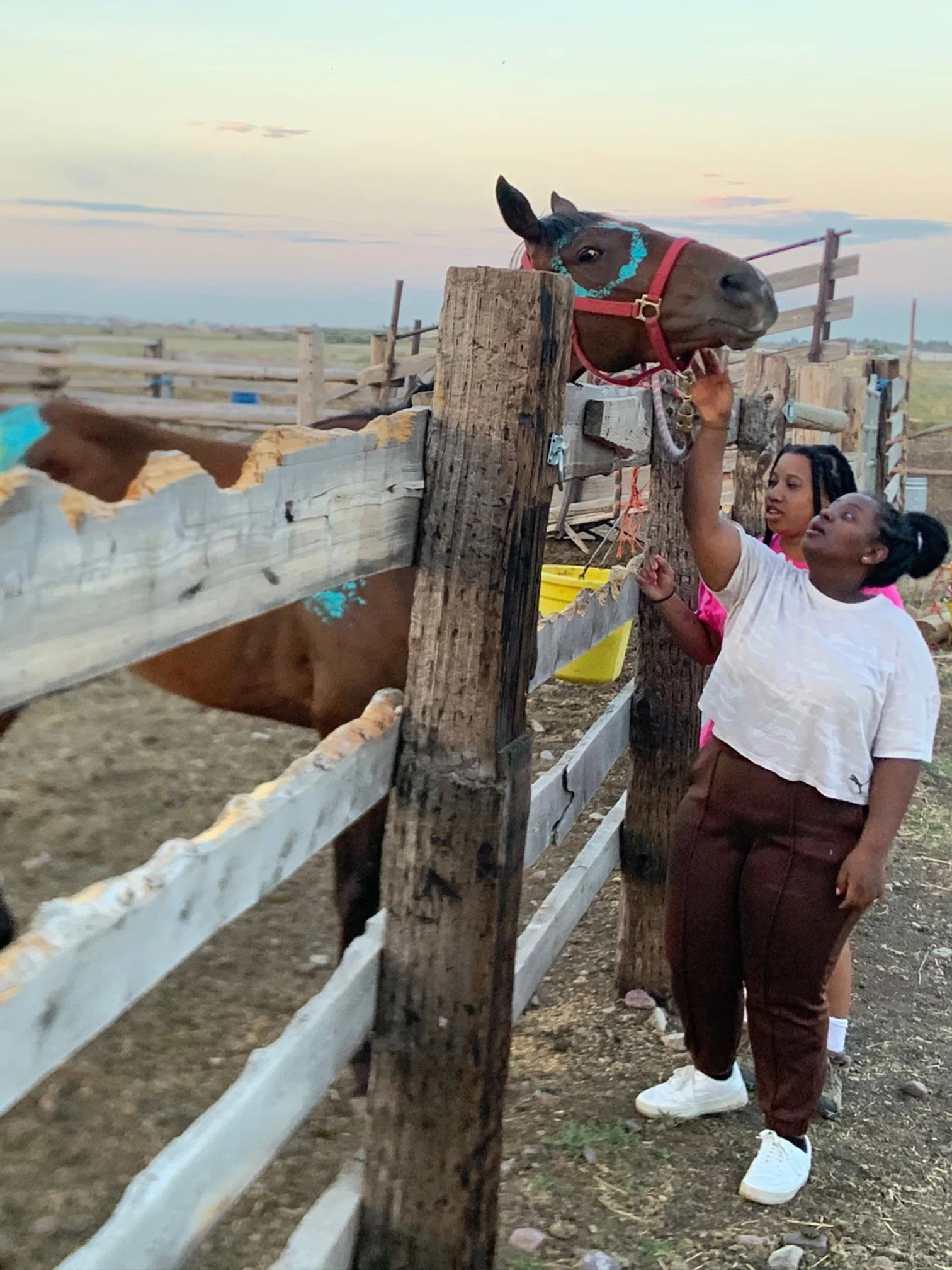
I got involved with VISIONS with the Buffalo Program. This was my first year (2022). [We did a] fencing project with VISIONS kids for the project. We had some kids come out and help us fence in our buffalo fields. We also had Iinnii Days and we did a buffalo harvest.
It wasn’t just for the VISIONS kids; a lot of people from Browning were there [for Iinnii Days and the harvest]. I introduced myself when I first met them, told them what I did, let them know what they’d be doing. The adult they were with supplied all the tools. We got right after it. Got them working. They were a lot of help.
What kinds of things did you take away from your experience with the VISIONS program?
It was actually a pretty good experience for me, being able to work with some kids not from our area, people that have never been on a reservation or even out in the country. A lot of them didn’t know how to do anything at first but once we got them going they were rolling right along. One of the boys at the harvest was a lot of help because he had been hunting before. They were all good, polite kids, not lazy, [and] had great work ethic.
What do you hope to be doing 10 years from now?
Probably have my ranch set to where I have, maybe putting up hay on my own, have a few more cattle, still working for the Buffalo Program and see that it’s still successful and growing with our herd. Seeing my kids succeed in school and go to college, have their own places and things, stuff they need, watch them do really good in life.
Anything you’d like to say to other members of the VISIONS community?
If you get the opportunity to work with VISIONS, take it. Every kid needs to learn good work ethic and good role models.
Anything else to add?
My mom works with VISIONS (Joan Cobell). She is a cook for the kids. I’m really glad we both got to be part of [VISIONS]. I never knew I would be part of this, and being that she’s doing it, too, I’m proud of her for doing that and she’s proud of me, too, in the same way.
I want to mention my kids, my wife, my dad Ervin Carlson. He’s the director of the Blackfeet Buffalo Program. I really thank him, too, that our buffalo are where they’re at now. He’s the reason I relay now. He’s the one that started us out with horses. He’s a big part of my life, of becoming a horseman, putting me on the right path in life. He’s the main man behind the relays. He’s one of the really old-school guys, one of the guys that started it. It used to just be ranch horses, not race horses. He’s come a long way and he’s still doing it. I’m very proud of him and what he does.
I have a lot of people that help me on my team. I couldn’t do it without them. I want to mention the names of my main team. My holders: Slew Costel (my cousin), and Cade Racine (my son), and my mugger: Roland Cobell (my uncle).
